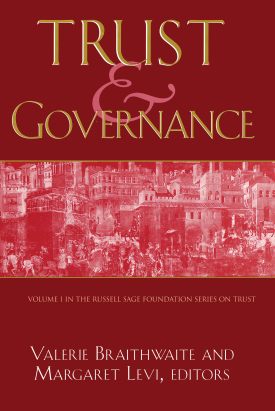In the United States today, women represent about half of the salaried workforce. This includes both single mothers and married women. When women live in families with another adult, it is highly likely that both adults will be employed outside the home. Yet despite their greater involvement in the workforce over the last several decades, and men’s greater involvement at home, women’s responsibilities for the care of dependent children and adults have not significantly decreased.
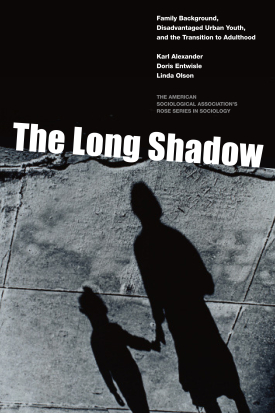
The Long Shadow
About This Book
A Volume in the American Sociological Association’s Rose Series in Sociology
Winner of the 2015 Grawemeyer Award for the Best Book in Education
Honorable Mention, 2016 Robert E. Park Award Presented by the American Sociological Association’s Community and Urban Sociology Section
“A fitting capstone for the efforts of a remarkable team of collaborators and their longitudinalstudy of working class children growing up in Baltimore.”
—GREG J. DUNCAN, Distinguished Professor, University of California, Irvine
“The Long Shadow profoundly challenges our understanding of schooling in the lives of disadvantaged urban children, black and white. They and their more privileged classmates are followed from first grade into young adulthood. Numerous policy- relevant observations emerge, including the
persistence of first grade inequalities and the recurrence of summer setbacks in learning. This is an essential book for all who care about children’s education.”
—GLEN H. ELDER, JR., Howard W. Odum Research Professor of Sociology and Research Professor of Psychology, Carolina Population Center, University of North Carolina at Chapel Hill
West Baltimore stands out in the popular imagination as the quintessential “inner city”—gritty, run-down, and marred by drugs and gang violence. Indeed, with the collapse of manufacturing jobs in the 1970s, the area experienced a rapid onset of poverty and high unemployment, with few public resources available to alleviate economic distress. But in stark contrast to the image of a perpetual “urban underclass” depicted in television by shows like The Wire, sociologists Karl Alexander, Doris Entwisle, and Linda Olson present a more nuanced portrait of Baltimore’s inner city residents that employs important new research on the significance of early-life opportunities available to low-income populations. The Long Shadow focuses on children who grew up in west Baltimore neighborhoods and others like them throughout the city, tracing how their early lives in the inner city have affected their long-term well-being. Although research for this book was conducted in Baltimore, that city’s struggles with deindustrialization, white flight, and concentrated poverty were characteristic of most East Coast and Midwest manufacturing cities. The experience of Baltimore’s children who came of age during this era is mirrored in the experiences of urban children across the nation.
For 25 years, the authors of The Long Shadow tracked the life progress of a group of almost 800 predominantly low-income Baltimore school children through the Beginning School Study Youth Panel (BSSYP). The study monitored the children’s transitions to young adulthood with special attention to how opportunities available to them as early as first grade shaped their socioeconomic status as adults. The authors’ fine-grained analysis confirms that the children who lived in more cohesive neighborhoods, had stronger families, and attended better schools tended to maintain a higher economic status later in life. As young adults, they held higher-income jobs and had achieved more personal milestones (such as marriage) than their lower-status counterparts. Differences in race and gender further stratified life opportunities for the Baltimore children. As one of the first studies to closely examine the outcomes of inner-city whites in addition to African Americans, data from the BSSYP shows that by adulthood, white men of lower status family background, despite attaining less education on average, were more likely to be employed than any other group in part due to family connections and long-standing racial biases in Baltimore’s industrial economy. Gender imbalances were also evident: the women, who were more likely to be working in low-wage service and clerical jobs, earned less than men. African American women were doubly disadvantaged insofar as they were less likely to be in a stable relationship than white women, and therefore less likely to benefit from a second income.
Combining original interviews with Baltimore families, teachers, and other community members with the empirical data gathered from the authors’ groundbreaking research, The Long Shadow unravels the complex connections between socioeconomic origins and socioeconomic destinations to reveal a startling and much-needed examination of who succeeds and why.
KARL ALEXANDER is John Dewey Professor of Sociology at Johns Hopkins University.
The late DORIS ENTWISLE was Research Professor in Sociology at Johns Hopkins University.
LINDA OLSEN is associate research scientist at Johns Hopkins University.
RSF Journal
View Book Series
Sign Up For Our Mailing List
Apply For Funding
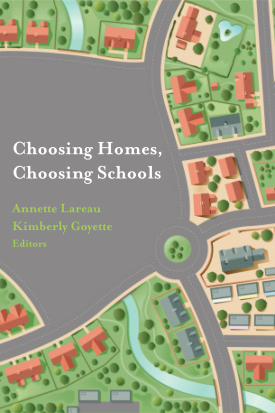
Choosing Homes, Choosing Schools
About This Book
“Where children live and attend school can exert powerful influences on their educational and social development. Understanding the forces at work in shaping patterns of residential and school segregation, therefore, is essential to understanding educational and social inequality in America. This thoughtful, theoretically rich, and empirically-grounded volume combines careful statistical analyses with rich, evocative parental interviews to provide a wealth of new evidence and insight into these complex forces. It is a ‘must-read’ for urban sociologists and education policy makers interested in understanding modern American inequality, segregation, and educational opportunity.”
—Sean Reardon, professor of sociology and director, Stanford Interdisciplinary Doctoral Training Program in Quantitative Education Policy Analysis
“Choosing Homes, Choosing Schools is an outstanding volume with contributions from prominent scholars that provides a detailed accounting of how residential and school sorting processes are intricately linked. The central theme is that residential segregation directly contributes to educational inequality, which in turn reinforces segregation when affluent (often white) families seek to avoid poor and minority schools. The book describes these processes in a changing social, demographic, economic, and policy context, and is informed by an excellent mix of theory, quantitative analysis, and qualitative work.”
—John Iceland, professor of sociology and demography, Penn State University
A series of policy shifts over the past decade promises to change how Americans decide where to send their children to school. In theory, the expanded use of standardized test scores and the boom in charter schools will allow parents to evaluate their assigned neighborhood school, or move in search of a better option. But what kind of data do parents actually use while choosing schools? Are there differences among suburban and urban families? How do parents’ choices influence school and residential segregation? Choosing Homes, Choosing Schools presents a breakthrough analysis of the new era of school choice, and what it portends for American neighborhoods.
The distinguished contributors to Choosing Homes, Choosing Schools investigate the complex relationships among education, neighborhood social networks, and larger patterns of inequality. Paul Jargowsky reviews recent trends in segregation by race and class, and shows that while segregation between blacks and whites has declined overall since 1970, white parents are still more likely to choose to live in predominantly white neighborhoods. This skewed residential selection in turn drives racial inequality in public schools. Annette Lareau draws on interviews with parents in three suburban neighborhoods to analyze school-choice decisions. Surprisingly, she finds that middle- and upper-class parents do not rely on active research, such as school tours or test scores. Instead, their decision-making was largely informal and passive, with most simply trusting advice from friends and others in their network. Elliot Weinginer looks at how class differences among urban parents affect their approaches to choosing schools. He finds that while parents of all backgrounds actively consider their children’s education choices, middle- and upper-class parents relied more on federally mandated school report cards, district websites, and online forums, while working-class parents used network contacts to gain information on school quality. Amy Schwartz and Leanna Stiefel explore the connections between housing policy and education reform. They demonstrate the shortcomings of policies focused exclusively on “school choice”—or the practice of allowing students to cross district boundaries to better schools—and instead advocate for reducing educational inequality by expanding residential choice through measures such as housing subsidies and the redevelopment of public housing to include schools and community centers.
Little previous research has explored what role school concerns play in the preferences of white and minority parents for particular neighborhoods, and how the racial and economic makeup of both neighborhoods and schools mutually reinforce each other. Choosing Homes, Choosing Schools adroitly addresses this gap and provides a firmer understanding of how Americans choose where to live and send their children to school.
ANNETTE LAREAU is Stanley I. Sheerr Term Professor in the Social Sciences and professor of sociology at the University of Pennsylvania.
KIMBERLY GOYETTE is associate professor of sociology at Temple University.
CONTRIBUTORS: Michael D. M. Bader, Felicia Butts, Kyle Crowder, Lori Delale-O’Connor, Stefanie DeLuca, Kimberly Goyette, Caroline Hanley, Paul A. Jargowsky, Shelley McDonough Kimelberg, Maria Krysan, Annette Lareau, Mary Pattillo, Anna Rhodes, Salvatore Saporito, Amy Ellen Schwartz, Leanna Stiefel, Elliot B. Weininger
RSF Journal
View Book Series
Sign Up For Our Mailing List
Apply For Funding
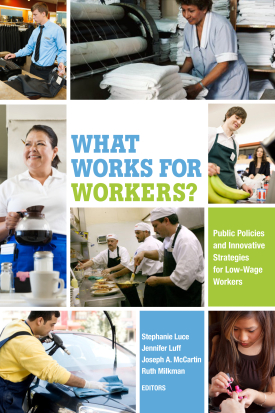
What Works for Workers?
About This Book
The majority of new jobs created in the United States today are low-wage jobs, and a fourth of the labor force earns no more than poverty-level wages. Policymakers and citizens alike agree that declining real wages and constrained spending among such a large segment of workers imperil economic prosperity and living standards for all Americans. Though many policies to assist low-wage workers have been proposed, there is little agreement across the political spectrum about which policies actually reduce poverty and raise income among the working poor. What Works for Workers provides a comprehensive analysis of policy measures designed to address the widening income gap in the United States.
Featuring contributions from an eminent group of social scientists, What Works for Workers evaluates the most high-profile strategies for poverty reduction, including innovative “living wage” ordinances, education programs for African American youth, and better regulation of labor laws pertaining to immigrants. The contributors delve into an extensive body of scholarship on low-wage work to reveal a number of surprising findings. Richard Freeman suggests that labor unions, long assumed to be moribund, have a fighting chance to reclaim their historic redistributive role if they move beyond traditional collective bargaining and establish new ties with other community actors. John Schmitt predicts that the Affordable Care Act will substantially increase insurance coverage for low-wage workers, 38 percent of whom currently lack any kind of health insurance.
Other contributors explore the shortcomings of popular solutions: Stephanie Luce shows that while living wage ordinances rarely lead to job losses, they have not yet covered most low-wage workers. And Jennifer Gordon corrects the notion that a path to legalization alone will fix the plight of immigrant workers. Without energetic regulatory enforcement, she argues, legalization may have limited impact on the exploitation of undocumented workers. Ruth Milkman and Eileen Appelbaum conclude with an analysis of California’s paid family leave program, a policy designed to benefit the working poor, who have few resources that allow them to take time off work to care for children or ill family members. Despite initial opposition, the paid leave program proved more acceptable than expected among employers and provided a much-needed system of wage replacement for low-income workers. In the wake of its success, the initiative has emerged as a useful blueprint for paid leave programs in other states.
Alleviating the low-wage crisis will require a comprehensive set of programs rather than piecemeal interventions. With its rigorous analysis of what works and what doesn’t, What Works for Workers points the way toward effective reform. For social scientists, policymakers, and activists grappling with the practical realities of low-wage work, this book provides a valuable guide for narrowing the gap separating rich and poor.
STEPHANIE LUCE is associate professor of labor studies at the Murphy Institute, CUNY School for Professional Studies.
JENNIFER LUFF is lecturer in the department of history, Durham University, U.K.
JOSEPH A. McCARTIN is professor of history at Georgetown University.
RUTH MILKMAN is professor of sociology at the CUNY Graduate Center.
CONTRIBUTORS: Eileen Appelbaum, Peter B. Edelman, Richard B. Freeman, Jennifer Gordon, Sarah Hamersma, Harry J. Holzer, Stephanie Luce, Jennifer Luff, Joseph McCartin, Ruth Milkman, Alice O’Connor, John Schmitt, Paul Osterman, David Weil, Jeffrey B. Wenger
Download
RSF Journal
View Book Series
Sign Up For Our Mailing List
Apply For Funding
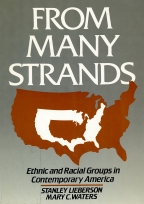
From Many Strands
About This Book
The 1980 Census introduced a radical change in the measurement of ethnicity by gathering information on ancestry for all respondents, regardless of how long ago their forebears migrated to America, and by allowing respondents of mixed background to list more than one ancestry. The result, presented for the first time in this important study, is a unique and sometimes startling picture of the nation's ethnic makeup.
From Many Strands focuses on each of the sixteen principal European ethnic groups, as well as on major non-European groups such as blacks and Hispanics. The authors describe differences and similarities across a range of dimensions, including regional distribution, income, marriage patterns, and education. While some findings lend support to the "melting pot" theory of assimilation (levels of educational attainment have become more comparable and ingroup marriage is declining), other findings suggest the persistence of pluralism (settlement patterns resist change and some current occupational patterns date from the turn of the century).
In these contradictions, and in the striking number of respondents who report no ethnic background or report it incorrectly, Lieberson and Waters find evidence of considerable ethnic flux and uncover the growing presence of a new, "unhyphenated American" ethnic strand in the fabric of national life.
STANLEY LIEBERSON is professor of sociology at Harvard University.
MARY C. WATERS is assistant professor of sociology at Harvard University.
A Volume in the RSF Census Series
Download
RSF Journal
View Book Series
Sign Up For Our Mailing List
Apply For Funding
About This Book
An effective democratic society depends on the confidence citizens place in their government. Payment of taxes, acceptance of legislative and judicial decisions, compliance with social service programs, and support of military objectives are but some examples of the need for public cooperation with state demands. At the same time, voters expect their officials to behave ethically and responsibly. To those seeking to understand—and to improve—this mutual responsiveness, Trust and Governance provides a wide-ranging inquiry into the role of trust in civic life.
Trust and Governance asks several important questions: Is trust really essential to good governance, or are strong laws more important? What leads people either to trust or to distrust government, and what makes officials decide to be trustworthy? Can too much trust render the public vulnerable to government corruption, and if so what safeguards are necessary? In approaching these questions, the contributors draw upon an abundance of historical and current resources to offer a variety of perspectives on the role of trust in government. For some, trust between citizens and government is a rational compact based on a fair exchange of information and the public's ability to evaluate government performance. Levi and Daunton each examine how the establishment of clear goals and accountability procedures within government agencies facilitates greater public commitment, evidence that a strong government can itself be a source of trust. Conversely, Jennings and Peel offer two cases in which loss of citizen confidence resulted from the administration of seemingly unresponsive, punitive social service programs.
Other contributors to Trust and Governance view trust as a social bonding, wherein the public's emotional investment in government becomes more important than their ability to measure its performance. The sense of being trusted by voters can itself be a powerful incentive for elected officials to behave ethically, as Blackburn, Brennan, and Pettit each demonstrate. Other authors explore how a sense of communal identity and shared values make citizens more likely to eschew their own self-interest and favor the government as a source of collective good. Underlying many of these essays is the assumption that regulatory institutions are necessary to protect citizens from the worst effects of misplaced trust. Trust and Governance offers evidence that the jurisdictional level at which people and government interact—be it federal, state, or local—is fundamental to whether trust is rationally or socially based. Although social trust is more prevalent at the local level, both forms of trust may be essential to a healthy society.
Enriched by perspectives from political science, sociology, psychology, economics, history, and philosophy, Trust and Governance opens a new dialogue on the role of trust in the vital relationship between citizenry and government.
VALERIE BRAITHWAITE is associate director of the Research School of Social Sciences at the Australian National University, Canberra, Australia. She is also coordinator of the Trust Strand of the Reshaping Australian Institutions Project in the Research School of Social Sciences.
MARGARET LEVI is professor of political science and Harry Bridges Chair in Labor Studies, University of Washington, Seattle. She is also director of the University of Washington Center for Labor Studies.
A Volume in the Russell Sage Foundation's Series on Trust
RSF Journal
View Book Series
Sign Up For Our Mailing List
Apply For Funding
Pagination
- Previous page
- Page 46
- Next page

